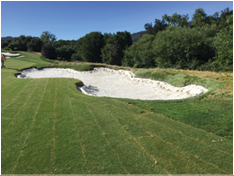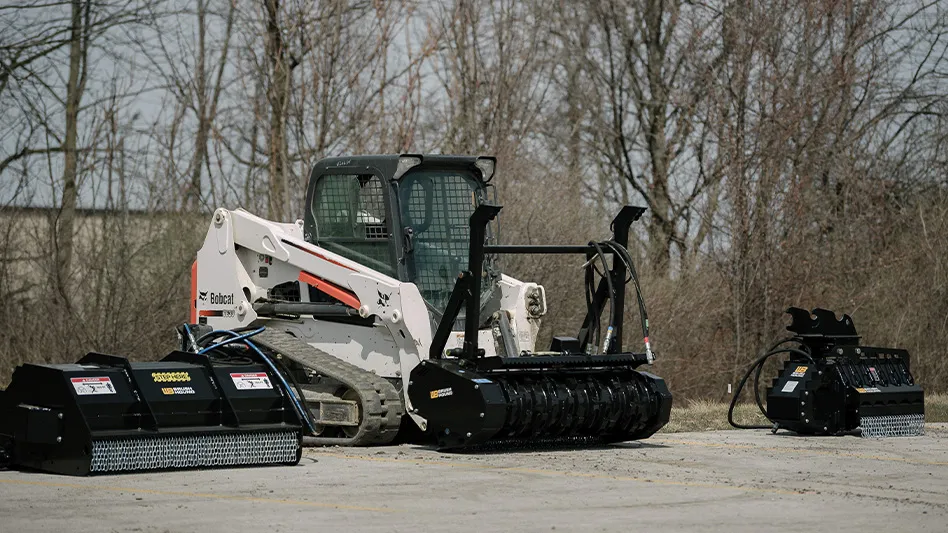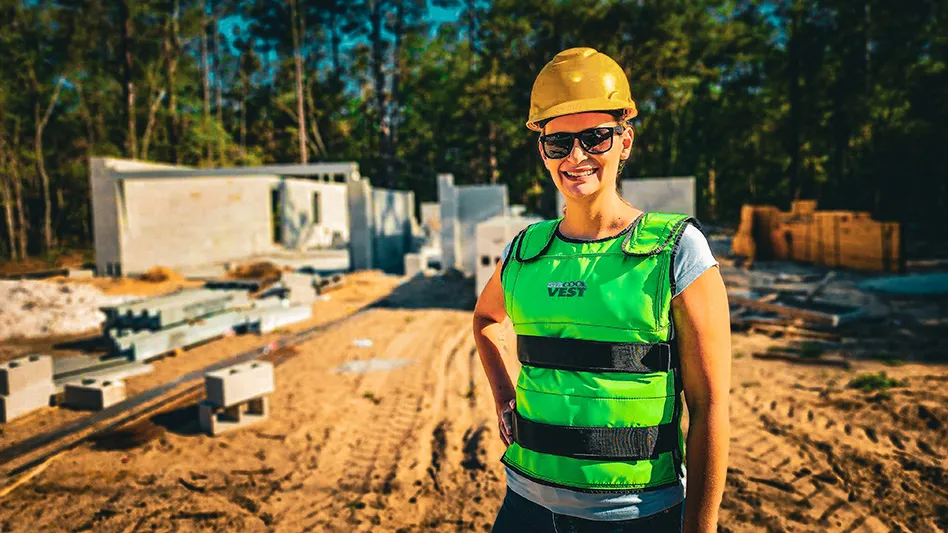
In drought-ravaged California, savvy golf industry folk deploy water-saving products and techniques wherever they can find them.
At The Preserve Golf Club, located in the semi-arid hills above Carmel, a recently completed fairway conversion project was more or less inspired by the canny observations of an off-duty superintendent hundreds of miles to the south.
“California has some of the strongest water restrictions in the nation and Santa Barbara County has the most strict regulations in the state,” says Tim Jackson, a principal with Jackson Kahn Design, which oversaw The Preserve renovation. “Roger Robarge, the superintendent at The Valley Club in Montecito, was the first to regrass with Santa Ana Bermuda after he saw a polo field nearby that, despite being in the middle of drought, looked fantastic.”
Santa Ana is the strain of Bermudagrass commonly found on many of Australia’s Sand Belt courses. It’s an older variety that had never curried a lot of favor in North America, but The Valley Club installation proved a bit of a breakthrough. “It’s a great fairway grass,” Jackson says. “Very hardy, little fertility, few pathogens. It’s gaining much wider acceptance and usage now.”
Perfect for The Preserve, right?
Well, not so fast.

“Cory Isom, the former superintendent here [now at The Roaring Fork Club in Basalt, Colo.], was the guy who spearheaded this conversion from bent to Bermuda,” Jackson says, “but The Preserve sits outside the perceived northern range of California’s Bermuda zone. The experts said, ‘This isn’t going to work.’ But Cory did four different test plots of Bermuda and paspalum over the course of 18 months and the new superintendent, Tim Taagen, agreed that the Santa Ana could work well there.”
GCBAA member Landscapes Unlimited handled the conversion, sodding 29 acres of fairway (and undertaking an extensive bunker renovation) beginning on April 1, 2016. The members were back on the golf course June 16.
Even in the wettest of times, with the most efficient Bermudagrass fairways, water is always going to be an issue at The Preserve GC, which is located on a massive, topographically dramatic, 20,000-acre property studded with ancient oaks (there’s even a section of redwoods). The Tom Fazio design is mainly irrigated from wells and storage reservoirs located off course. Taagen gets a bit more reclaimed effluent from the property’s sewage treatment facility, but not much. The wells only produce 10-40 gallons per minute in the heat of summer.
“Now, if they go through a tough period of drought, they can just let the fairways dry out with far less effect,” says Clay Fetherbay, the Landscapes Unlimited project manager at The Preserve — and at Shady Canyon Golf Club down south in Irvine, where the company recently completed a green, bunker and irrigation renovation under the direction of Jackson Kahn.
Taagen confirmed that if The Preserve gets its expected 26 inches of rain each winter, no problem. If they don’t, with Santa Ana fairways, there’s no problem either. “Typically, as a superintendent, you’re looking at something cutting edge — you’d never look at something as old as Santa Ana,” he says. “But it’s got the ability to green up earlier in the spring. It maintains a tinge of green through the winter like a typical modern hybrid Bermuda … We can’t overseed here, because if we have four to five good winters in a row, the ryegrass would never leave. But because we’re right on the cusp of Bermuda barely wanting to survive here, it doesn’t really move into the cool-season grasses.”
Taagen adds that prior to the conversion, his sand-capped fairways were so thin, carts left tracks in the landing zones. As a result, “Our roughs took a terrible beating. Now our fairways are great, but we’re fighting to get our perennial ryegrass roughs back in shape. They’re getting better each week.”
Meeting expectations with less water
Jackson displays a strong affinity for the agronomic side of the equation at The Preserve, but then his turf savvy shouldn’t come as any big surprise. The 42-year-old Hoosier graduated from Purdue University in 1999, with a degree in agronomy — having spent a good chunk of his college days participating in Pete Dye’s overhaul of the school’s Kampen Course. Jackson would join Tom Fazio’s firm upon graduation. There he met David Kahn. The two would form their own firm, based in Scottsdale, Ariz., in 2009.
“All of the credit at The Preserve should go to Cory Isom and Tim Taagen, who recognized the opportunity to cut way back on water use, without sacrificing conditioning,” Jackson says. “And once the project went ahead, it went way beyond your typical regrassing. Once you’re on that property, which is tucked way up in the hills, deliveries take 45 minutes to reach the golf course. The only access on course is the cart path network, so the logistics to get sod and materials around the property while minimizing damage was really difficult. Landscapes did a tremendous job in executing the project.”
At the Tom Fazio-designed Shady Canyon, 350 miles to the south, Jackson Kahn, Landscapes Unlimited and director of agronomy John Nachreiner collaborated and ultimately rooted out several more agronomic issues, one of which recalls Taagen’s point about the dangers of overseeding in California.
“We all know that in coastal California, you should not overseed Bermuda fairways,” Jackson says. “The first few years are fine but eventually Poa annua moves in, and then you can’t get rid of it — not like you can in the desert, where the ryegrass cannot survive the summers. On the coast, you never get that true transition back to Bermuda.”
Alas, not all developers studied agronomy at Purdue.
‘Unfortunately, at times, developers make decisions based on criteria other than best agronomic practices. In the case of Shady Canyon’s developers, The Irvine Company, they felt that a ‘green’ golf course would be help in selling real estate. But once you overseed, even if it’s just once, you never get it back and they did experience a slow and steady decline in conditions on account of the Poa/rye/Bermuda blend. When the membership took the club over a few years back, they regrassed the fairways.”
_Tim_Jackson_fmt.png)
Did they use Santa Ana? The city of Santa Ana is right next to Irvine, after all…
“No, they have a blend of Princess 77, which is a seeded variety the super at the time selected, and remnants of the originally installed 419. But when they converted, they kept the cool-season ryegrass rough because the greens committee liked the aesthetics — the contrast of green against dormant Bermuda fairways in winter. Problem was, the irrigation was designed for Bermuda wall to wall. So Landscapes put in a supplemental rough irrigation system that created a hard line between rough and fairway, because they have such vastly different water requirements. Essentially we gave John Nachreiner the control he needed to create the conditions members expected.”
Added Nachreiner, “If you’re putting water through irrigation heads that could be 85-90 percent efficient and they’re only 65 percent, it makes sense to use that commodity in a better way. So we replaced the central control, all the heads and at same time put in a dual-turf system with supplemental heads around fairways to water the ryegrass rough.”
The “conditions members expect” can be a moving target: Shady Canyon may eventually get rid of its ryegrass rough. Nachreiner resodded three holes last August with Bermuda rough; the membership is still mulling this decision, but the new irrigation works either way.
“To grow in the ryegrass without oversaturating the fairways, we needed more accuracy,” Nachreiner says. “Even if we do go to Bermuda rough, we now have the versatility to keep the rough a bit more irrigated, more lush and dense, to contrast it with the fairways. To water the roughs independent of fairways — to give my south-facing rough some extra irrigation — is always a bonus. Most supers in the world would kill for that.”
Getting the sand right
Jackson Kahn’s work at Shady Canyon has been done in several phases, the last of which — rebuilding the back 9 bunkers — will take place in 2017. In the last three years, Landscapes Unlimited has rebuilt the front nine bunkers, refashioned the fifth hole almost entirely, added a short-game area featuring three USGA greens and installed this highly targeted rough-irrigation system. Landscapes Unlimited also rebuilt all 18 putting surfaces, in reaction to another SoCal-specific, water-centric phenomenon.
According to Jackson, generally speaking there are only three sand sources available to golf course contractors in Southern California. The greens at Shady Canyon were built in 2001, using a larger, more homogenous, rounded sand that met USGA specifications and performed just fine for several years.

“However, for the first several years as they were topdressing with this larger aggregate parent material and the members were not pleased,” Jackson says. “So what happened is typical: the superintendent tries very hard to appease the membership and, in the interest of play issues, not agronomic issues, changed the practices. He started using a finer sand with tighter capillary pore space. When you create a finer sand layer above a more coarse sand layer, you essentially seal the green off over time. The water couldn’t release through the profile, which ultimately inhibited root development, led to wet conditions (which promoted Poa annua), and greatly impacted conditioning.”
The solution: Jackson, Nachreiner and Landscapes Unlimited rebuilt all 18 greens, coring them out to a depth of 8-9 inches, leaving the original, deepest sand layer and restoring the profile using uniform sand components. Using GPS mapping, the greens were put back largely to their original contours, “with some improvements,” the architect says. “We also greatly benefitted from the advice and experience of Bel Air superintendent Brian Sullivan and Dr. Trey Rogers, head of the turfgrass program at Michigan State, who consulted on the project.”
“The sand is something that we watch closely now,” Nachreiner says. “When you look at the science of USGA greens, you want to maintain the same particle size distribution as your original construction mix. Today we test every load of topdressing sand to make sure it’s the same sand we built the golf course with. We learned our lesson there.”

Explore the October 2016 Issue
Check out more from this issue and find you next story to read.
Latest from Golf Course Industry
- Devising safer landings
- SiteOne adds Durentis to product offerings
- Resilia available for purchase in Hawaii
- What can $1 million do for expanding the industry workforce?
- Captivating short course debuts on Captiva Island
- Wonderful Women of Golf 35: Carol Turner
- The Andersons acquires Reed & Perrine Sales
- Excel Leadership Program awards six new graduates





